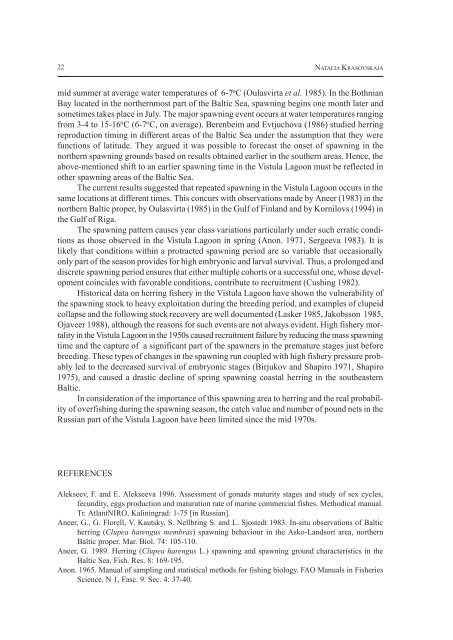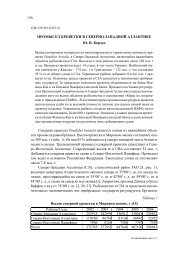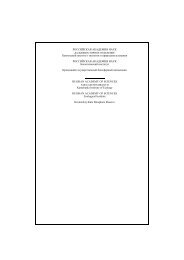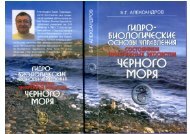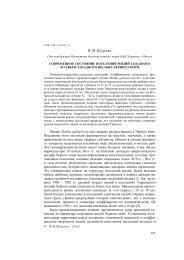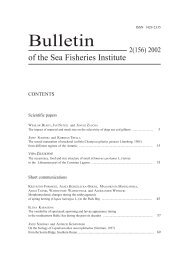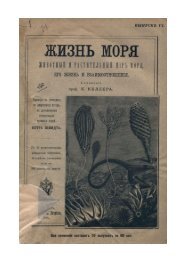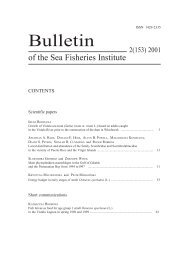Bulletin of the Sea Fisheries Institute 1 (155) 2002 - CEEMaR
Bulletin of the Sea Fisheries Institute 1 (155) 2002 - CEEMaR
Bulletin of the Sea Fisheries Institute 1 (155) 2002 - CEEMaR
Create successful ePaper yourself
Turn your PDF publications into a flip-book with our unique Google optimized e-Paper software.
22<br />
NATALIA KRASOVSKAJA<br />
mid summer at average water temperatures <strong>of</strong> 6-7 o C (Oulasvirta et al. 1985). In <strong>the</strong> Bothnian<br />
Bay located in <strong>the</strong> nor<strong>the</strong>rnmost part <strong>of</strong> <strong>the</strong> Baltic <strong>Sea</strong>, spawning begins one month later and<br />
sometimes takes place in July. The major spawning event occurs at water temperatures ranging<br />
from 3-4 to 15-16 o C (6-7 o C, on average). Berenbeim and Evtjuchova (1986) studied herring<br />
reproduction timing in different areas <strong>of</strong> <strong>the</strong> Baltic <strong>Sea</strong> under <strong>the</strong> assumption that <strong>the</strong>y were<br />
functions <strong>of</strong> latitude. They argued it was possible to forecast <strong>the</strong> onset <strong>of</strong> spawning in <strong>the</strong><br />
nor<strong>the</strong>rn spawning grounds based on results obtained earlier in <strong>the</strong> sou<strong>the</strong>rn areas. Hence, <strong>the</strong><br />
above-mentioned shift to an earlier spawning time in <strong>the</strong> Vistula Lagoon must be reflected in<br />
o<strong>the</strong>r spawning areas <strong>of</strong> <strong>the</strong> Baltic <strong>Sea</strong>.<br />
The current results suggested that repeated spawning in <strong>the</strong> Vistula Lagoon occurs in <strong>the</strong><br />
same locations at different times. This concurs with observations made by Aneer (1983) in <strong>the</strong><br />
nor<strong>the</strong>rn Baltic proper, by Oulasvirta (1985) in <strong>the</strong> Gulf <strong>of</strong> Finland and by Kornilovs (1994) in<br />
<strong>the</strong> Gulf <strong>of</strong> Riga.<br />
The spawning pattern causes year class variations particularly under such erratic conditions<br />
as those observed in <strong>the</strong> Vistula Lagoon in spring (Anon. 1971, Sergeeva 1983). It is<br />
likely that conditions within a protracted spawning period are so variable that occasionally<br />
only part <strong>of</strong> <strong>the</strong> season provides for high embryonic and larval survival. Thus, a prolonged and<br />
discrete spawning period ensures that ei<strong>the</strong>r multiple cohorts or a successful one, whose development<br />
coincides with favorable conditions, contribute to recruitment (Cushing 1982).<br />
Historical data on herring fishery in <strong>the</strong> Vistula Lagoon have shown <strong>the</strong> vulnerability <strong>of</strong><br />
<strong>the</strong> spawning stock to heavy exploitation during <strong>the</strong> breeding period, and examples <strong>of</strong> clupeid<br />
collapse and <strong>the</strong> following stock recovery are well documented (Lasker 1985, Jakobsson 1985,<br />
Ojaveer 1988), although <strong>the</strong> reasons for such events are not always evident. High fishery mortality<br />
in <strong>the</strong> Vistula Lagoon in <strong>the</strong> 1950s caused recruitment failure by reducing <strong>the</strong> mass spawning<br />
time and <strong>the</strong> capture <strong>of</strong> a significant part <strong>of</strong> <strong>the</strong> spawners in <strong>the</strong> premature stages just before<br />
breeding. These types <strong>of</strong> changes in <strong>the</strong> spawning run coupled with high fishery pressure probably<br />
led to <strong>the</strong> decreased survival <strong>of</strong> embryonic stages (Birjukov and Shapiro 1971, Shapiro<br />
1975), and caused a drastic decline <strong>of</strong> spring spawning coastal herring in <strong>the</strong> sou<strong>the</strong>astern<br />
Baltic.<br />
In consideration <strong>of</strong> <strong>the</strong> importance <strong>of</strong> this spawning area to herring and <strong>the</strong> real probability<br />
<strong>of</strong> overfishing during <strong>the</strong> spawning season, <strong>the</strong> catch value and number <strong>of</strong> pound nets in <strong>the</strong><br />
Russian part <strong>of</strong> <strong>the</strong> Vistula Lagoon have been limited since <strong>the</strong> mid 1970s.<br />
REFERENCES<br />
Alekseev, F. and E. Alekseeva 1996. Assessment <strong>of</strong> gonads maturity stages and study <strong>of</strong> sex cycles,<br />
fecundity, eggs production and maturation rate <strong>of</strong> marine commercial fishes. Methodical manual.<br />
Tr. AtlantNIRO, Kaliningrad: 1-75 [in Russian].<br />
Aneer, G., G. Florell, V. Kautsky, S. Nellbring S. and L. Sjostedt 1983. In-situ observations <strong>of</strong> Baltic<br />
herring (Clupea harengus membras) spawning behaviour in <strong>the</strong> Asko-Landsort area, nor<strong>the</strong>rn<br />
Baltic proper. Mar. Biol. 74: 105-110.<br />
Aneer, G. 1989. Herring (Clupea harengus L.) spawning and spawning ground characteristics in <strong>the</strong><br />
Baltic <strong>Sea</strong>. Fish. Res. 8: 169-195.<br />
Anon. 1965. Manual <strong>of</strong> sampling and statistical methods for fishing biology. FAO Manuals in <strong>Fisheries</strong><br />
Science. N 1, Fasc. 9. Sec. 4: 37-40.


